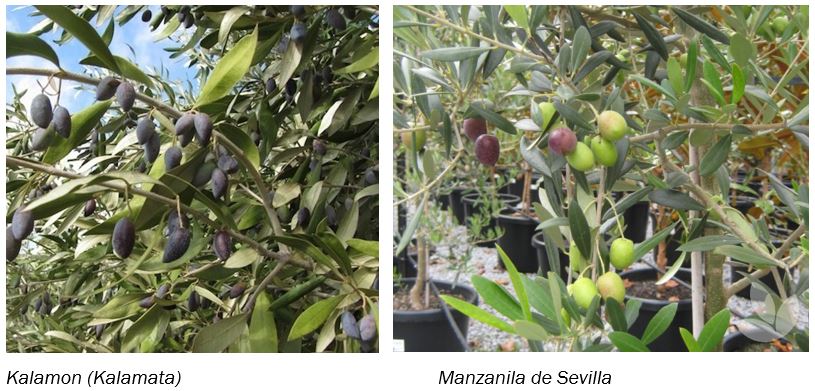30 May Cultivars suitable for table olive processing
30 May 2021

The National Table Olive Committee (NTOC) will be systematically seeking cultivar information from growers, researchers, nurseries, and international sources relevant to identifying cultivars suitable to table olive processing.
Some cultivar information is available in IOC Publications, The NOVA Trial, nurseries and research papers. Accurate cultivar information is required and needs to be collated in a practical way for the production of quality raw olives and processed table olives. For high quality table olives, the staring material raw olives must also be of highest quality. Unfortunately, Australian consumers are mostly exposed to few table olive products compared to those available in the Mediterranean region.
Potential table olive cultivars for the Australian Table olive industry:

Table: Adapted from Professor Stan Kailis
- Cultivars in bold italics = commercially available in Australia
- Cultivars in italics = some internationally recognised table olive cultivars
- Cultivars in non-italics starting from ‘Amelon’ = cultivars involved in the Nova Trials at Roseworthy, SA
Questions raised by NTOC:
- Do Australian table olive producers need a better understanding of cultivars for table olive growing and processing?
- Currently only a limited number of cultivars are being processed into table olives – these tend to be Kalamon (Kalamata) and Manzanilla de Sevilla (similar to supermarket table olives). If Australian table olive producers are looking for a competitive edge the use of additional cultivars needs to be explored.
- Need to increase the cultivar base available to Australian table olives, with emphasis on selection, productivity of raw olives and include technical information pre, and post-processed olives.
- Develop technical profiles for selected table olives. Having very good information on the cultivars available for table olives and how they perform at processing would be very useful – some cultivars are more relevant to being processed into table olives than others.
- More information on the varieties available for making table olives and how to use them would be very beneficial. (As well as how to grow these varieties). Is a cultivar better suited to non-irrigated/irrigated, cooler climates/hot climates?
- It would be handy for producers to have olive cultivar characteristics. What happens to the cultivar when fermented? Eg is there a green olive that becomes mild when it is fermented?
- From a marketing perspective, in the table olives section of the supermarket, consumers see lots of jars labelled as Kalamata and the rest are labelled generic, green olives. Educating the consumer about the various varieties available – listing on the label of Australian table olives would be good.
What are current limitations?
- Imports that are predominantly treated olives – Spanish style-green, Sicilian Style green and
Californian black ripe olives and Naturally black ripe olives (mainly Kalamon cv) - The infancy in development of the Australian table olive industry (even though table olives have
been processed for over 100 year) - There also many internationally recognised table olive cultivars especially from Greece, Italy, Spain, Portugal, France and Turkey that are not available in Australia.
- A relatively large olive germplasm pool is available in Australia – those available commercially from nurseries and possibly others and some 50 feral varieties planted in the experimental farm at the University of Adelaide Roseworthy Campus (SA) – The National Olive Variety Assessment (NOVA) project trial, these varieties are not available anywhere else in the world. The NOVA trial report is a useful reference. Also see The development of a genetic database to identify olive cultivars by Jenny R Guerin et al AMER. SOC. HORT. SCI. 127(6):977–983. 2002.
- It would also be good to have unique Australian varieties to avoid future conflicts over naming rights eg Kalamata.
- Established olive farms have named and possibly some un-named cultivars. How genuine are these cultivars and have the cultivars been confirmed by DNA testing?
- Olive ID: A genetic identification service for most commercially grown olive cultivars in Australia is commercially available through AGRF. The test is based on findings of the NOVA trial (National Olive Variety Assessment) conducted on behalf of the RIRDC, and concluded in 2005. The study found that over 50 of the most commonly grown varieties had consistent genetic makeup. Only these varieties are covered by the current test, as it was found that the other varieties tested consisted of more than one clonal variety. Contact AGRF for Olive DNA testing:
Cathryn Todd, Cathryn.Todd@sa.gov.au
AGRF contact is Freecall: 1300 247 301
NTOC welcomes further input to this discussion on the need for more commercial table olive varieties to be grown in Australia.
AOA will be undertaking a survey in July / August 2021 to gather important information on table olive production practices, including varieties grown – your participation is invited and encouraged.
